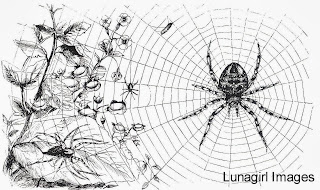This time of year the garden spiders weave webs everywhere. It was misty this morning, and my son noticed dew-covered webs on the way to school. I have been seeing them on the bushes out front. We wondered: why don't the spiders make these webs during the summer? We only notice them in spring and fall.
Inspired by the spiders, some thoughts about spinning. Spinning is a
magical act -- think how often it appears in fairy tales, like Sleeping
Beauty and Rumpelstiltskin. Fairy tales are remnants of old mythologies, often girls' initiation
stories whose roots are lost in the mists of time. Spinning -- which occupied much of women's time for thousands of years -- was
connected with coming of age for young women, and you can see that in
the old stories if you look. You'll find girls and goddesses at their spinning wheels, beauties and brides spinning straw into gold. Penelope weaving her tapestry waiting for Odysseus to come home.
In European mythology spinning and weaving were tasks nearly always performed by women and girls. Twenty thousand years ago, women were spinning fibers and weaving cloth
to create the first fabrics. Right up until the Industrial Revolution,
spinning and weaving and sewing were women's work, sometimes for pay, always a tremendous contribution to the family economy and the larger economy.
A really fascinating book about "women, cloth, and society in early times" is Women's Work: The First 20,000 Years by Elizabeth Wayland Barber. I bought it years ago and just got around to reading it recently. Couldn't put it down! Yes, I'm a big-ole history nerd.
Spinning and weaving (like baking and gardening) are transformative, turning one thing
into another. Spinning is sometimes associated with
the moon, which measures the months and pulls the tides. Weaving is associated with dreaming and memory and the creation of a new reality.
In Greek mythology, the Three Fates spin our lives and our fates.Clotho spins the thread, Lachesis measures it out, and Atropos cuts it!
In Greek mythology even Zeus feared the Fates (usually called the
Moirai). In Norse mythology the Norns are very similar.
On the third night of a child's life, the Fates were supposed to come
and determine a child's destiny. Sound familiar from The Sleeping
Beauty? Three fairy godmothers?
Spinning stories, spinning lies, spinning thoughts into words,
measuring our time and destinies.
One more spinner who often shows up in mythology and folklore all over the world:
Neith, the spinner of destiny, to the Egyptians. Arachne, whose weaving
rivaled that of the goddess Athena, to the ancient Greeks. Anansi the
trickster in West African stories, who is also the bringer of rain, the
king of stories and the giver of gifts such as agriculture.
From the
Native Americans, Iktomi the wise/foolish god of the Lakota and Ojibwa
dreamcatchers (ever notice that they are like spiderwebs?) Spider Woman
or Spider Grandmother in Hopi mythology is the creator of all life. The spinner/weaver is a very old goddess, and cultures all over the world seem to recognize her.
In
the Southern U.S. it is good luck when a spider weaves her web in your
house or garden (not the poisonous kind of course!) So I guess the garden spinners are bringing us good fortune.




No comments:
Post a Comment